After a terrible start to the 2022/23 Belgian Pro League season where the club sat bottom with only one win from their opening nine matches, Austrian Dominik Thalhammer was sacked by Cercle Brugge.
His replacement came from within, with Thalhammer’s assistant and compatriot Miron Muslić taking charge at the Jan Breydelstadion after being promoted from assistant manager.
The 40-year-old Austrian has had immense success so far, with him dragging the club all the way up from the bottom of the table to currently sitting in 8th place, which occupies the last spot in the European playoffs.
This tactical analysis will take a more in-depth look at Miron Muslić tactics, with the Austrian losing only 4 of his 19 matches in charge of Cercle Brugge so far.
Miron Muslić Tactics & Preferred Formations
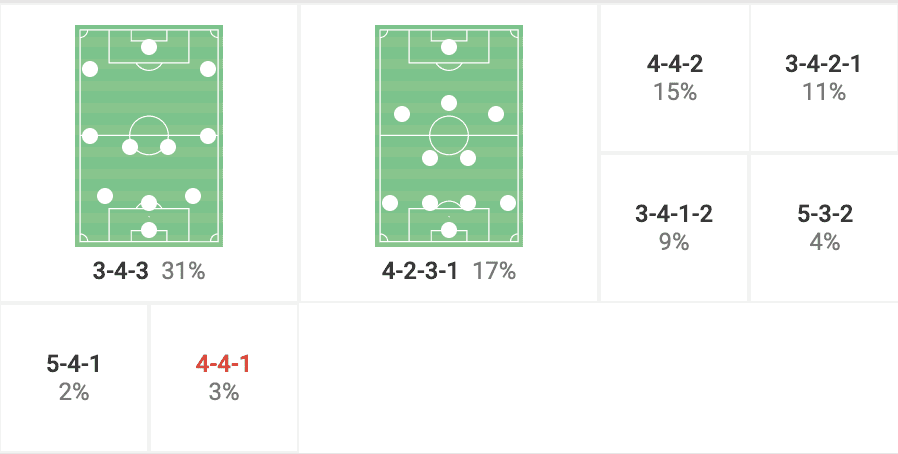
The image above shows the formations that Miron Muslić has used so far during his time in charge of Cercle Brugge.
The Austrian has alternated between a wide variety of formations during his 19 matches in charge, but in recent matches, he has seemed to settle on some form of a back-three system.
In the last few matches, the Austrian has begun to start with a 3-4-1-2, with this formation being fluid.
At times it will transition into a 3-4-3, or even a 3-4-2-1, with the goal of Muslić’s side to defend from the front, using their high-octane counter-pressing ability to win possession back in the attacking half of the pitch.
Miron Muslić Intense high-pressing system
Much like his predecessor Dominik Thalhammer, one of the main principles of Miron Muslić’s game model is intense high pressing, with the Belgian side being the best in the country at both pressing and counter-pressing moments.
The Austrian has very much improved upon this full-throttle pressing system that Thalhammer implemented when he was appointed, with this being one of the foundations that Muslić has built his style of play around.
Under Muslić, Cercle Brugge are not a side that hold the majority of the possession in a match, so this intense counter-pressing helps them to win back possession in the advanced areas of the pitch.
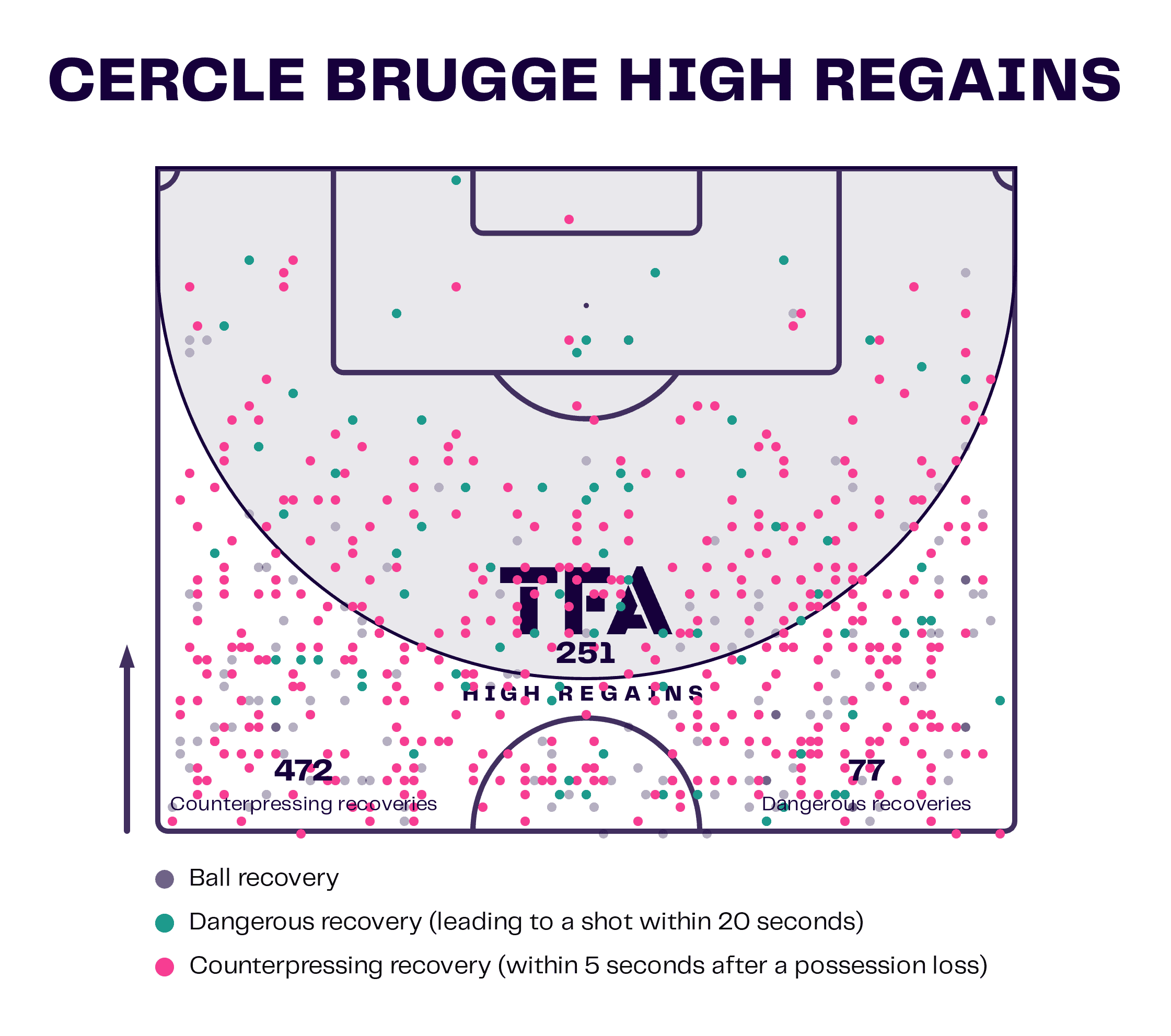
The image above shows Cercle Brugge’s high regains since Miron Muslić took over from Thalhammer late last year.
During that time period, the Belgian side are statistically the best counter-pressing side in the Belgian league, with the Bruges club having 251 high regains in that time period.
They also have 472 counterpressing recoveries, with 77 of those being dangerous and leading to a shot.
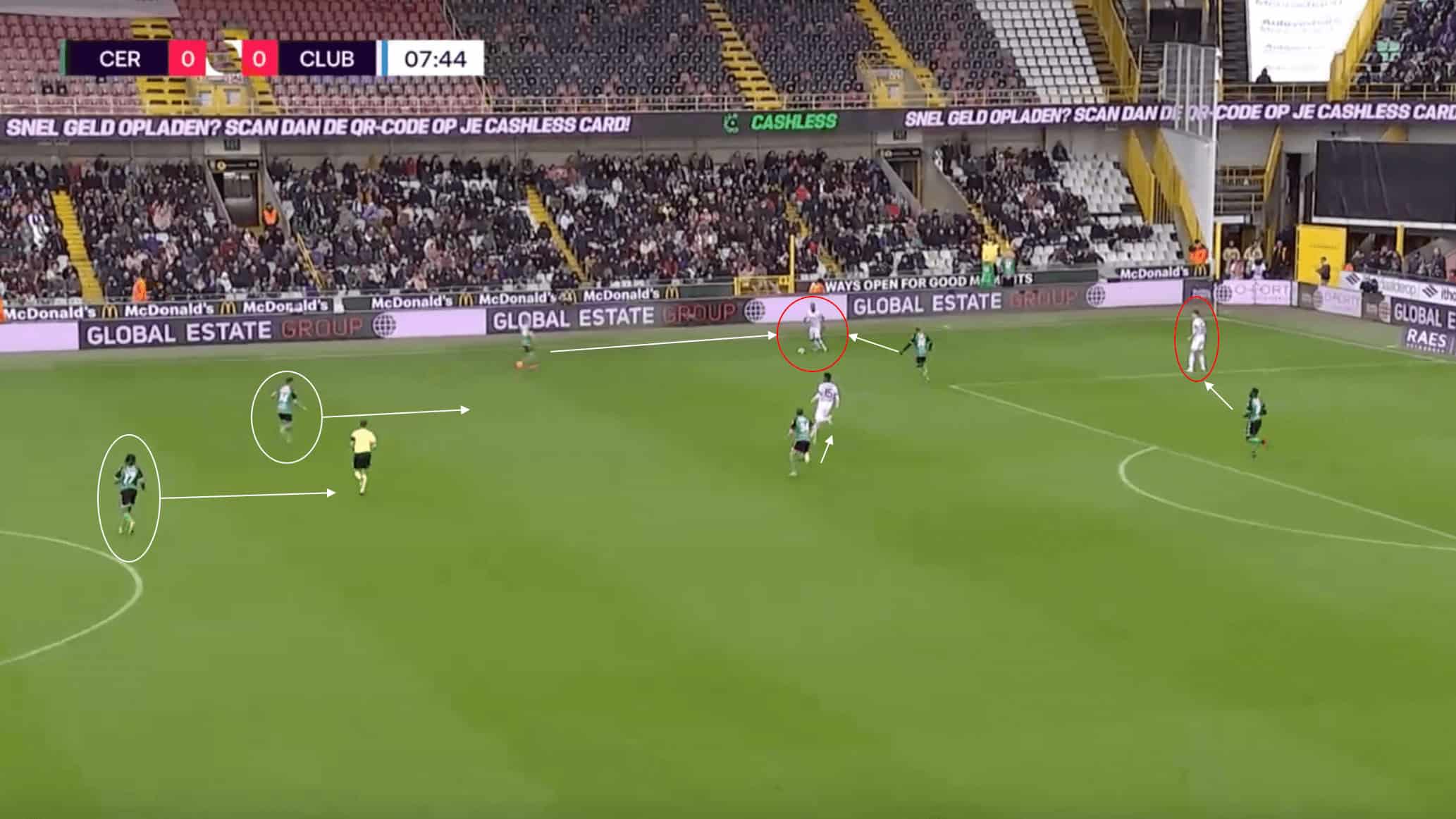
The image above shows an example of the pressing style that Cercle Brugge utilise under Miron Muslić.
As the phase of play shows above, Club Brugge are in possession, with the fullback in possession on the far touchline.
As the ball reaches this player, two Cercle players work to quickly close down the fullback and force him into a rushed decision.
The ball is then played back to the centre-back, who is again put under immediate pressure by the Cercle Brugge striker.
This pass back is a cue for the two deeper Cercle players to push up, with them being 6v3 against Club Brugge in this pressing moment.
This immediate pressure and numerical advantage allow Cercle to win possession back just outside the penalty box and results in an attempt on goal that goes just wide of the former Liverpool goalkeeper Simon Mignolet’s post.
Another interesting thing to note is the numbers that Cercle push forward in these pressing moments, with them not looking to settle and drop back in a defensive shell when they either lose possession in an advanced area or when the opposition are looking to build out from the back.
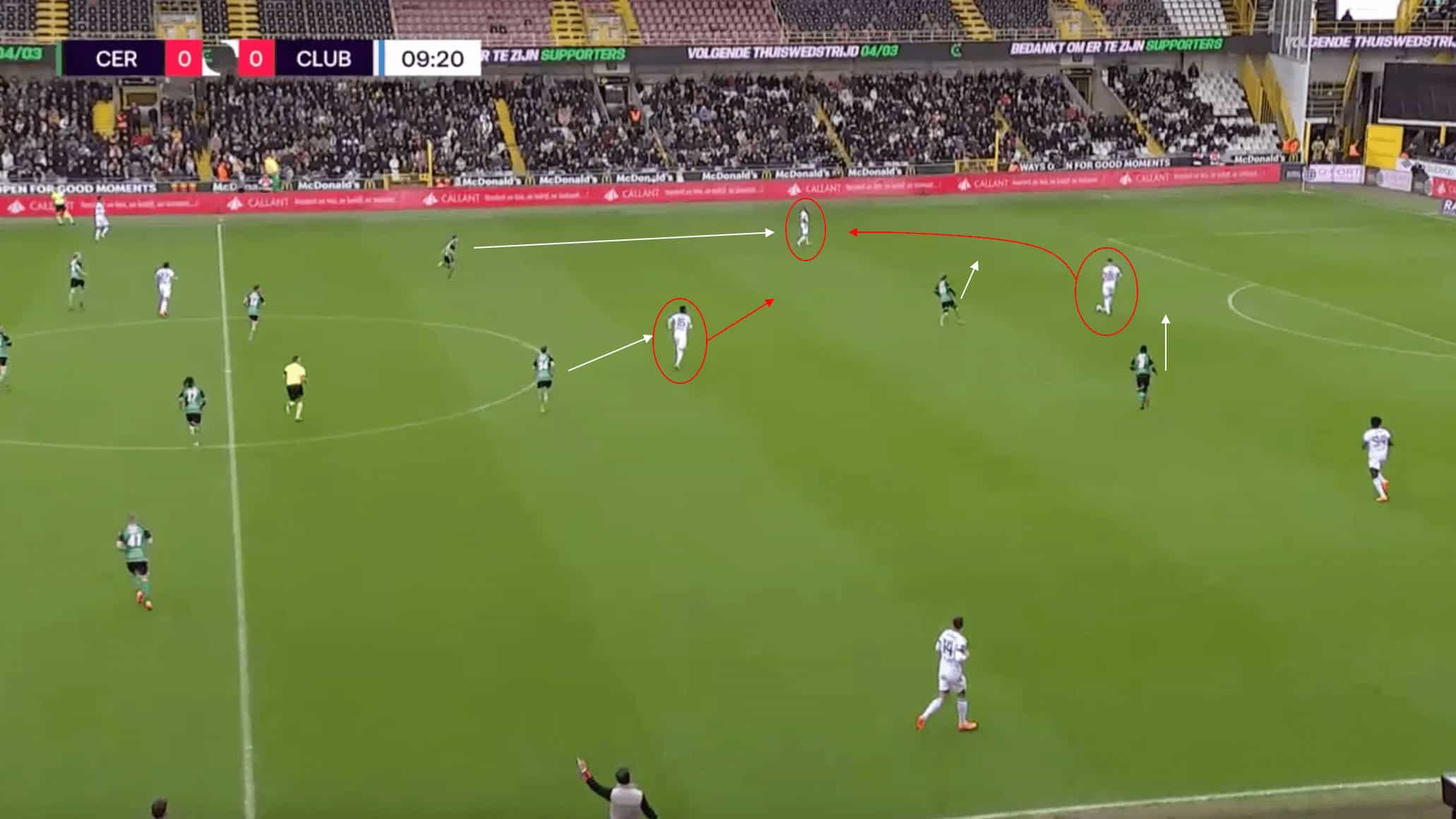
The image above again shows another example of the team pressing that allows Cercle Brugge to win possession back in an advanced area.
The phase of play above is not a counter-pressing sequence, rather, it comes off of a Gent throw-in from inside their own defensive third.
The throw-in is played back to the centre-back, who is closed down quickly by Kevin Denkey.
In the central space, Ayase Ueda is able to recognise the potential passing lane and quickly jumps into it, preventing a pass to either the goalkeeper or the opposite centre-back.
As a result, the Gent player in possession is forced to play the ball long to the opposite fullback, who is closed down by the Cercle Brugge wing-back only a few seconds later, allowing the Belgian side to again gather possession in a very advanced attacking area.
When it comes to pressing cues, as well as the negation of spaces in certain areas of the pitch, the entire side are on the same page, which allows them to consistently have success winning back possession in these advanced areas of the opposition’s half.
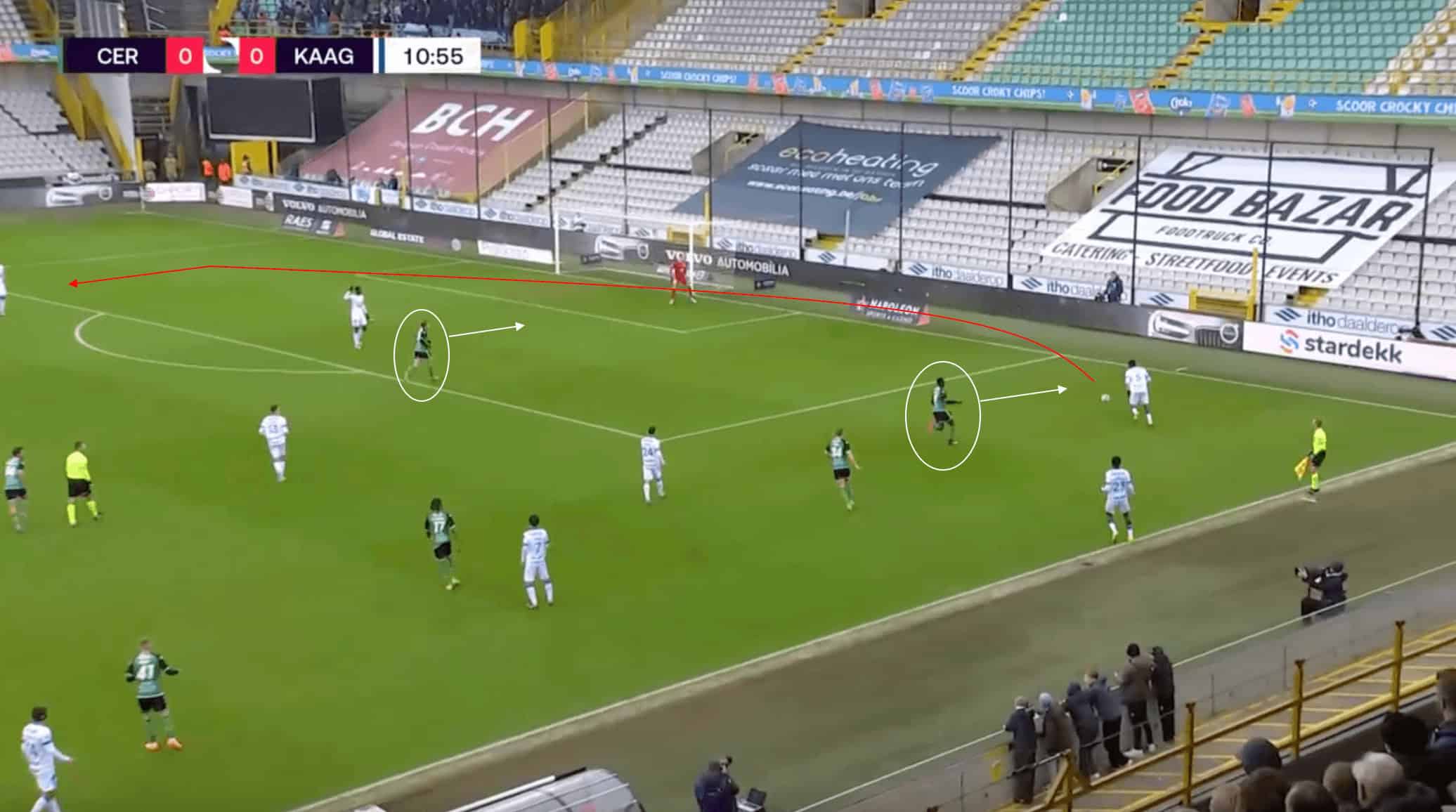
The image above shows a similar pressing sequence from the same match against Club Brugge.
In the phase of play above, which is a build-up phase from the Belgian league champions, Cercle do well to force the ball to one side.
This pressing movement of the forwards means that the centre-back can only realistically play to one short option, which is the fullback on the far touchline.
As a result, the furthest advanced Cercle Brugge players who are pressing the ball already know where it is going to be played.
This allows them to lock the ball to one side, with the Cercle wing back also pushing forward to make it a 4v3 pressing advantage in this phase of play.
As this play develops, Club Brugge looks to try and play through the press as opposed to going long to try and escape it.
This allows Cercle to once again regain possession in an advanced area, as Club pay for attempting to play through the pressure.
The use of this high-intensity pressing/counter-pressing system is one of the building blocks of the style of play that Miron Muslić has looked to implement during his short time in charge of Cercle Brugge so far.
This has allowed the Belgian club to essentially punch above their weight in the Belgian league this season and has helped them to rise up the table from bottom to inside the European playoff places.
Miron Muslić Direct style of build-up
As mentioned previously in this tactical analysis, Cercle Brugge under Miron Muslić are not a side that look to hold the majority of possession in a match, nor do they try to build out from the back often.
They often look to play direct from the goalkeeper, with them playing for second balls inside the opposition’s half.
While they also look to win the initial header as much as possible, the Cercle Brugge players tend to position themselves in favourable positions to give them the best possible chance of winning the second balls and gathering possession.
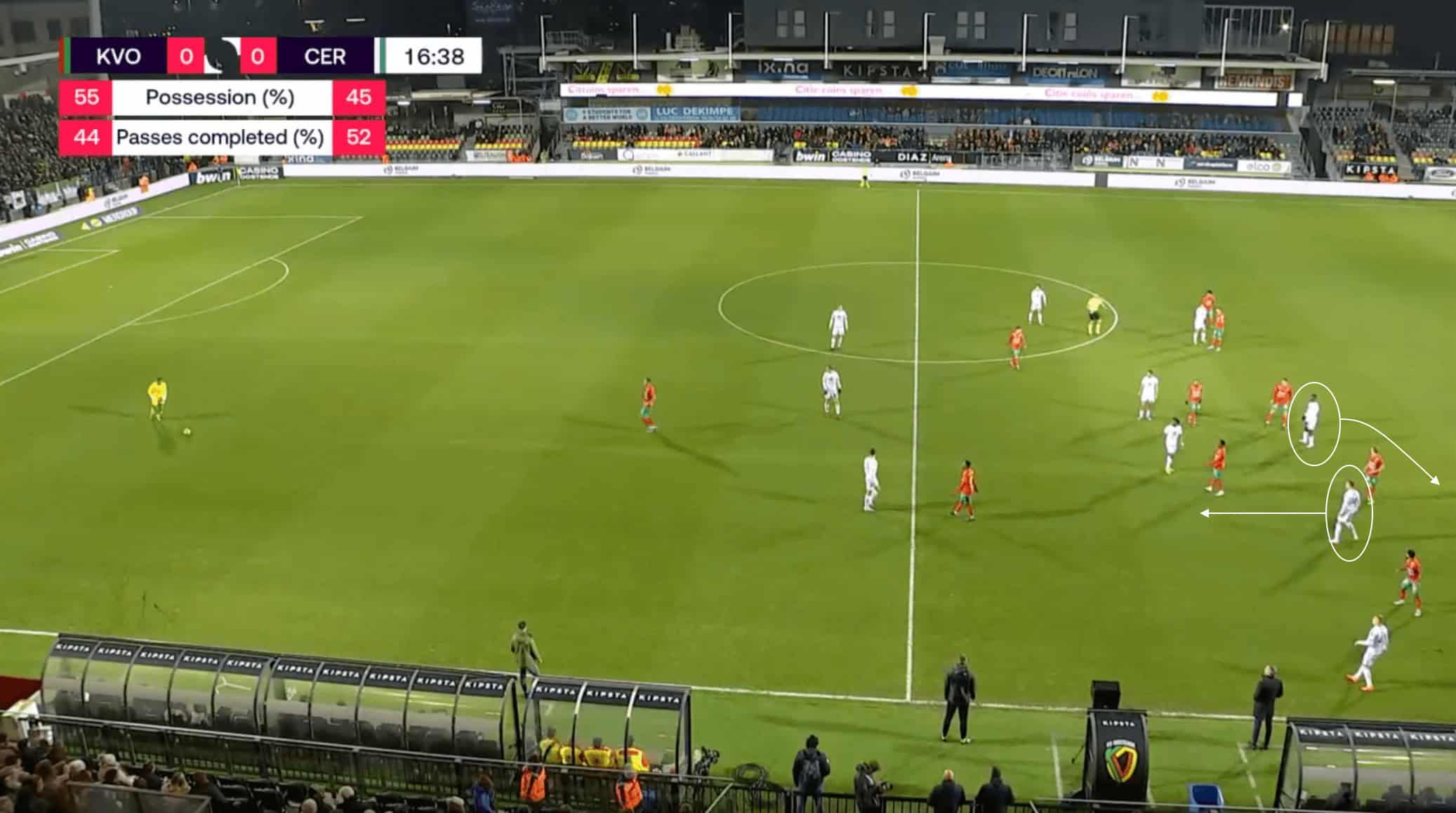
The image above shows the direct style of build-up that Cercle Brugge typically uses during matches.
In this phase of play, the ball is played back to the goalkeeper after possession is gathered by Cercle, with all of the outfield players for the Belgian side pushing forward.
We can see how tight and compact both sides are, and can make out the three-at-the-back variation that Muslić prefers to set his side up in.
As mentioned, Cercle looks to attack both the first and second ball, with attacking players normally looking to position themselves where it gives them a better chance at winning the second ball.
This is exactly a scenario like this in the phase of play pictured above.
As the ball is played long by Warleson, the Cercle attacker circled drops a bit deeper to try and win the initial header.
This movement drags out the defender marking him, which allows the striker to position himself behind to attempt to receive a flicked-on attempt.
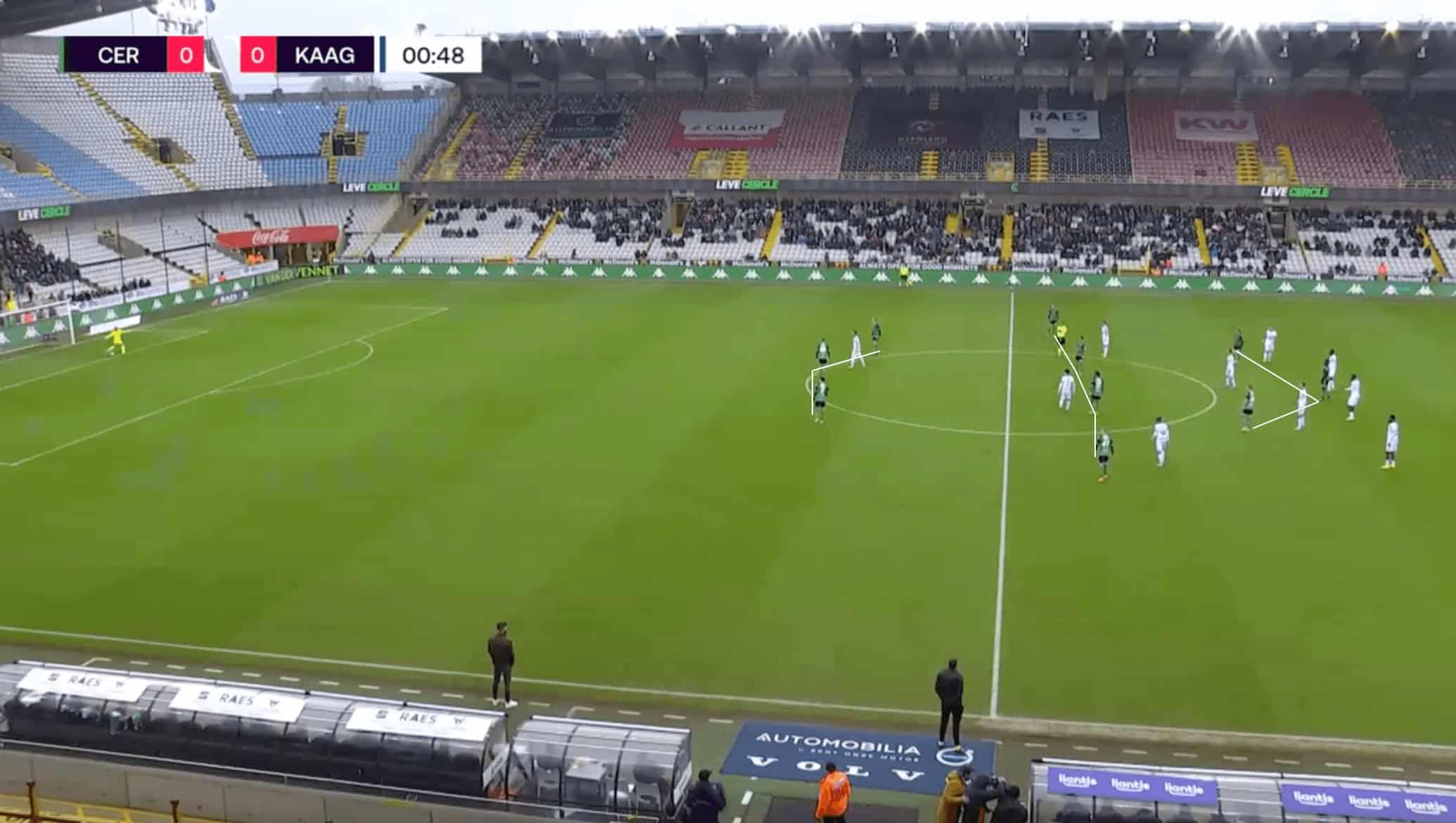
The image above shows the Cercle Brugge shape during attacking build-up phases of play, with the Belgian side looking to dominate aerially to win the first and second balls.
As the goal kick is taken long from Cercle Brugge’s goalkeeper, the players are around the midfield line position to get themselves ready for the second ball.
As the ball reaches its intended target area on the pitch, Gent are able to win the first ball in the air.
However, due to the compactness of the Cercle Brugge shape, they are able to swarm the Gent players as the ball is in the air, which allows them to quickly close down as they end up not being first to the second ball.
As a result of this quick closing down, Gent are forced to knock the ball forward, allowing Muslić’s side to relieve pressure and attempt to play long again into the attacking half of the pitch.
A common trend for Cercle Brugge under the Austrian manager is the use of constant pressure on the opposition while they are in possession, which works well in partnership with this direct form of building, especially when they are not first to the second ball as it allows them to quickly put pressure on the opposition and win possession back in the attacking half.
Conclusion
As this Miron Muslić tactical analysis and scout report has shown, Cercle Brugge have become a much better side since Miron Muslić has taken over.
Though he has only been in charge for 19 matches, he has drastically improved the side, with them going from the bottom of the table all the way into the European playoff places.
With Muslić’s intense pressing system, something that is similar to the style Thomas Tuchel used at Chelsea and PSG, or Ralph Hassenhüttl at both RB Leipzig and Southampton, the Belgian side have been very good, and are continuing to improve under the tactics of the Austrian manager.





Comments